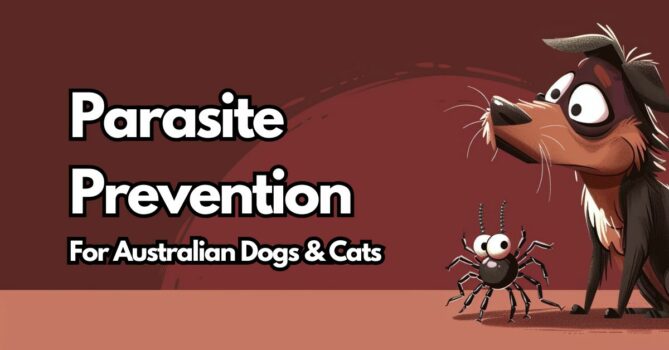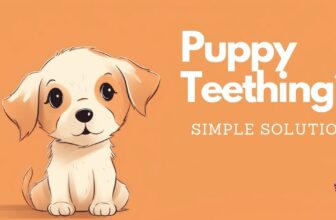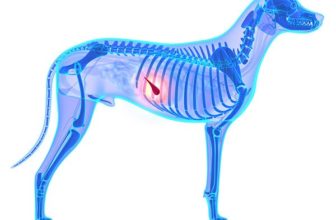Parasite Prevention: A Guide for Australian Dogs & Cats

My expertise is pet food, but my involvement in pet communities, the pet industry, and veterinarians has given me exposure to both the pros and cons of parasite treatments.
Personally I only use parasite protection treatments when necessary. I live in Perth which is low risk, which means most of the time I see no need to use a treatment. Only when my dog shows signs of a flea, or when we venture out on a camping trip do I opt to use a treatment such as NexGard.
In rural areas there is a much greater risk of parasites, which makes the use of parasite protection more necessary, and likely the much safer option.
In many areas of Australia, especially those with a significant risk of tick paralysis, infectious vector born disease, and heartworm, the benefits of parasite treatments can far outweigh the adverse drug reactions you may have heard of.
In this article we’ll cover all aspects of parasite protection and prevention – the different types and brands – and we will consider risks and benefits.
Is continuous use of parasite protection necessary?
Most pet owners opt for continuous use of parasite protection. This not only costs more, but I believe this may be unnecessary.
The answer may depend more on where you live in Australia, and the level of risk.
If you live within 20km of Australia’s eastern coast you are at high risk of paralysis ticks. Given the harm these can cause your dog, it is expected the benefits of a paralysis treatment far outweigh the small percentage of risk (which we will look at shortly).
Reference: Health.gov.au advice on paralysis ticks, including areas of high risk.
If you live in Perth, Adelaide, Melbourne, Sydney, or Brisbane, you should ask yourself if you really are at risk.
It concerns me when most pet owners continue to treat their dogs unnecessarily, month on month. Does the small element of risk outweigh the potential benefits?
Many veterinarians recommend continued treatment, as do the manufacturers themselves, but the question is whether this is to benefit your pet, or because this makes a great deal more money?
Call me skeptical, but I’ve seen how corporations market products in a way which generates more revenue. It happens often. It’s the reason we must feed our dogs processed kibble, for the sake of their health, when you would find it absolutely ridiculous if your doctor told you to only eat processed food for the sake of your health.
I may be wrong, or wrong in some cases, but I made a conscious choice to only use parasite protection on my pets when I consider it necessary, such as when I venture out of Perth on a camping trip, or notice my dog excessively scratching.
Addressing the concerns of parasite protection treatments
Searching the Internet for reactions and side effects of parasite protection treatments is alarming. It’s definitely not something I want to happen to my dog.
However, research shows these reactions are much less likely than we may think.
Reference: Journal of Veterinary Pharmacology and Therapeutics – Current review of isoxazoline ectoparasiticides used in veterinary medicine (March 2021)
I feel a great deal of information on the Internet is biased (i.e. to sell products), and on the flipside reactions to such a medication are often greatly exaggerated and viralised. Negatively spreads like wildfire, and real facts don’t.
Unfortunately that leaves us as pet owners confused. What is safe for our pets, and what isn’t?
The truth is many parasite protection treatments, whether spot-on, oral, or collar, do seem to come with some risk. I think that’s worth considering, but we should consider that pragmatically – risk vs benefit.
As a pet nutritionist I often question the general health of an animal which has had such a reaction. I don’t want to discount the possibility of a healthy dog suffering a reaction, but in many individual cases, on further inspection, there are other factors which should be considered.
Most Australian dogs are not in optimal health, or not fed an optimal diet. Some dogs are immune-compromised, from inadequate nutrition or from medication, antibiotics, and viruses.
Add a parasite protection treatment into the mix, whether spot-on or chew, we may find an adverse reaction more understandable. Parasite treatments are essentially chemical in nature, designed to interfere with the nervous systems of those parasites.
How healthy is your dog, and how healthy is their diet?
To put your mind at some rest, reactions to most parasite treatments in Australia are rare.
What are the different types of parasite treatment?
In Australia we have several options for parasite protection, primarily against fleas, ticks, heartworm, or intestinal worms.
The most popular treatments are topical treatments (spot-on), oral medication, or collars. Some opt for more natural and holistic methods of protection which I’ll cover later.
Here is a comparison of these commercial options:
Topical treatments (spot-on)
Popular products: Frontline Plus, Advantage, Revolution
These tend to cover fleas and ticks, and sometimes heartworms and mites. Most pet owners find these easy to apply to the back of the neck, but I advise you to vary the point of application if you use these products repeatedly.
It is vital your pet is not able to lick off the medication, which is why the back of the neck is the recommended point of application.
The dose of spot-on treatments are designed based on size and weight of your pet, to be used monthly.
Never use a spot-on treatment which is not for the size and weight of your pet.
Oral medications
Popular products: NexGard, Bravecto, Heartgard
These come in the form of an oral tablet which most dogs will happily eat (cats not so much). For a dog, coating the tablet in peanut butter (100% peanuts) or a wet dog food should do the trick.
For a cat, some wet food may help, but you may need to prise their mouth open and stick the tablet at the back of their tongue – this will cause them to swallow it rather than spit it out.
Some pets may have dietary sensitivities to the ingredients in oral medications.
Collars
Popular products: Seresto, Scalibor
Collars may not be as affective as spot-on and oral treatments, but can offer additional protection. Usually for up to 8 months against fleas and ticks.
Some pets can have a reaction to collars so keep an eye on the skin around their neck, and remove the collar immediately if they show any signs of a reaction.
The effectiveness of a collar can vary depending on environmental factors, so it’s worth asking on local pet community social media groups for advice and recommendations.
Where to buy parasite treatments
Frontline Plus
Advantage
Revolution
NexGard (Spectra)
Bravecto
Heartgard
Seresto
What natural methods can be used for parasite protection?
Natural and homeopathic methods may not be as reliable as commercial applications, but this does not mean they are ineffective.
Unfortunately due to the nature of science often being funded by private industry, not enough research goes into assessing the real benefits of natural preventatives which are likely less risky. Whatever decision you take to prevent parasites is ultimately your choice and what you feel comfortable with.
A good Australian Facebook group is As Nature Intended, and recommended if you are looking for advice on natural or homeopathic parasite treatments (or diet for that matter).
Below we will cover various potential ways of reducing the risk of parasites, using treatments, grooming, repellants, and environmental control:
Dietary supplements
Small amounts of garlic can help repel fleas. You will often read on the Internet that garlic is bad for dogs, but you should have little need to worry. Many years ago I read a research document on garlic toxicity in dogs, and from what I recall it was many cloves before any signs of sickness – I’m sure if we ate a great deal of garlic we would feel pretty ill too.
I recall one conversation where someone believed their dog had reacted to a small amount of garlic, which was what the vet had diagnosed, but other than that it is not something which seems to warrant the social media warnings.
Brewer’s yeast in a small moderation added to your dog’s food is believed to help repel fleas, although there is little research on this. I have seen natural flea treatments made with a combination of brewer’s yeast and garlic (or garlic oil) with mixed feedback.
A little apple cider vinegar in your pet’s drinking water may help the skin become slightly acidic and a deterrent towards fleas and ticks, although the effectiveness is anecdotal. In Japan and Korea apple cider vinegar is drunk in water as a health tonic in the belief it helps break down carbohydrates – if that’s true, and given most dog foods are high in unnecessary carbohydrates, this may have additional benefits.
Herbal treatments
Diluted neem oil is often used as a natural way to repel ticks and fleas. This can be used on your pet’s coat, but always in dillution.
Eucalyptus, lavender, and lemongrass oils are often used in natural flea and tick repellent solutions for pets, and often available as sprays. Any essential oil should be diluted, and always check for signs of irritation.
Grooming & care
When it comes to fleas, a combination of combing and bathing can help catch fleas before they can cause an infestation. From experience, bathing and combing is best done with a natural flea shampoo which helps stick the fleas to the comb – otherwise they jump off onto the carpet, back on your pet, or on you.
If you suffer a flea infestation (I’ve been there, and it’s horrible!), the only way to fight the battle is both on your pets and the environment.
I’ve spoken to many frustrated pet owners over the years who’ve faced an endless battle treating their dog, but the fleas don’t stop because they’re in the environment. The battle is 50% on your pet, and 50% in the environment.
Make sure you regularly clean pet areas, particularly carpets, pet beds, and play areas. This will help prevent fleas breeding, but if you have an infestation you will need to take a more serious approach – washing everything.
Natural environment control
Diatomaceous earth and nematodes are two methods of keeping fleas and ticks away from your home or yard.
Diatomaceous earth is a powder made from the fossilised remains of diatoms, a type of single-celled algae which shares biochemical features of both plant and animal but isn’t categorised as either (you can impress your partner with that nugget of knowledge!).
Sprinkled as a powder, diatomaceous earth can be used as natural pest control as it dehydrates fleas and ticks.
Benficial nematodes are microscopic worms which you can spread around your garden. They’re safe for both pets and plants, but not to fleas.
Heartworm prevention
A lot can be said for regular checkups at the vets, and if using natural preventatives against heartworm it is recommended you ask your vet to conduct heartworm testing.
Heartworms can be transmitted by mosquitos, which means warding off mosquitos can help prevent your dog getting heartworm. Using citronella as a mosquito repellant can reduce the risk.






